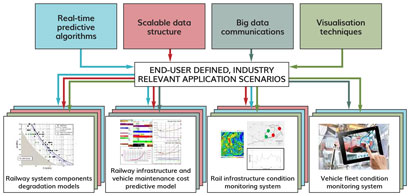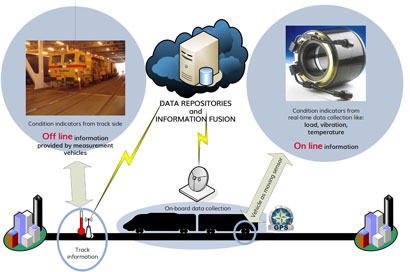
Railway systems have complex technologies, with a wide range of human actors, organisations and technical solutions. To control such complexity, a viable solution is to apply intelligent computerised systems. Here Professors Diego Galar, Uday Kumar and Ramin Karim from Luleå University of Technology, Sweden, explain the possibilities of big data in the railway industry and its positive effects on operations and maintenance (O&M) from a systems perspective.

Industry 4.0’ refers to the so-called fourth industrial revolution characterised by smart systems and Industrial internet-based solutions 1 . The transportation sector, especially railways, has largely adopted Industry 4.0. The use of new and emerging technologies is leading to improved quality of services, new savings, enhanced resource utilisation and efficiency. It has also facilitated the development of new services and business models based on the capability of the industrial internet and the analytics capabilities of big data. Big data has the potential to transform the current state-of-the-art railway technology platforms into a network of collaborative communities seamlessly moving freight and passengers and delivering services in a planned way. The current trend of automation and data exchange is towards adopting and adapting the new and emerging technologies to achieve new levels of effectiveness and efficiency. Big data in railways comes from interconnected stakeholders who provide intelligence to the railway system. The complete big data architecture includes cyber-physical systems, the Internet of Things (IoT) and Cloud computing, all of which work together to create ‘smart railways’. An application area that is generating considerable excitement is the possibility of better O&M through self-learning and smart systems that predict failure, make diagnoses and trigger maintenance actions. These systems make high demands on data access and data quality and use multiple data sources to extract relevant information 2 .
Big data analytics in railway O&M will use advanced technologies to perform predictive analytics and make decisions based on the analysis of huge amounts of data. Providing O&M services will involve data collection, analysis, visualisation, and decision-making for assets. The use of big data in O&M will address a common Achilles’ heel in asset management: that of status forecasting, commonly called prognosis. The estimation of the remaining useful life of an asset, in order to ascertain the probability of its mission accomplishment, constitutes the basis for any operation or maintenance service and, as such, is key to the success of any organisation 3 . The railway domain will achieve data interconnection via the train bus where most of the railway subsystems and their respective sensors will be accessible. The interconnection by data buses will open the door to global optimisation in a system of systems approach, replacing the old localised approach, notably its reduced scope for O&M of the whole asset 4 .
The objective of big data in railways is to enable predictive algorithms from heterogeneous data sources, scalable data structures, real-time communications, and visualisation techniques 5 . Such research is challenging in infrastructure asset maintenance in the railway environment in three particular areas: railway system component degradation prediction modelling; railway infrastructure and vehicle maintenance cost prediction modelling; and infrastructure and vehicle condition monitoring. The objectives of big data analytics in the railway industry are as follows:

Figure 1: Application of visualisation techniques of infographics and virtual/augmented reality
Big data analytics have the potential to influence several dimensions of the railway sector and can overcome organisational, operational and technical complexities, including economic and human effects and information handling.
Traffic Management Systems (TMSs) comprise sub-systems, often with limited integration capabilities and non-standardised interfaces and display rules. In fact, the number and varied nature of assets makes the integration of data sources extremely difficult; therefore, the network asset status information cannot be widely understood or exploited to inform TMS decision-making 3 . Even more challenging is the integration with other information domains such as maintenance related services, energy resources etc., as this must be done manually. In summary, O&M are completely disconnected in terms of incoming data sources and decision-making. The estimation of the remaining useful life (RUL) to check the probability of mission accomplishment by the asset constitutes the basis of any operations or maintenance service 3 . Figure 2 shows a common scenario; a vehicle’s status is merged with the infrastructure condition to forecast the vehicle’s condition and verify the user scenario selected by the on-board computer.

Figure 2: Big data applied in railway transportation as a fusion of vehicles and infrastructure sources
Big data will enable automated, interoperable, interconnected, and advanced traffic management systems; scalable and upgradable systems, using standardised products and interfaces, will enable easy migration from legacy systems. There will be a wealth of data and information on assets and traffic status, with information management systems adding the capability of nowcasting and forecasting critical asset statuses. The positive effects of being able to accurately forecast an asset’s status does not just provide benefits for maintenance planning, but also benefits other areas, for example, traffic management. The use of big data in railways will lead to improvement in the following operational areas:
Big data in railway will contribute to achieving the objectives of the EU Transport White Paper which states: ‘Transport is fundamental to our economy and society. Mobility is vital for the internal market and for the quality of life of citizens as they enjoy their freedom to travel. Transport enables economic growth and job creation: it must be sustainable in the light of the new challenges we face. Transport is global, so effective action requires strong international cooperation’. Many European companies are world leaders in infrastructure, logistics, traffic management systems and the manufacturing of transport equipment. As other world regions are launching huge, ambitious transport modernisation and infrastructure investment programmes, it is crucial that European transport continues to develop and invest, in order to maintain its competitive position. The sustainable maintenance of the infrastructure and vehicles is a ‘must’ on the European agenda. Big data analytics in railway will meet the following needs:
Last but not least, big data analytics have potential benefits for energy and sustainability in the railway domain. Better O&M will decrease the energy consumption and reduce the carbon footprint of assets, both rolling stock and infrastructure. The use of big data in the railway sector will optimise operation and maintenance methodologies by taking an holistic approach, considering the entire lifecycle of the asset in a ‘cradle to the grave’ approach and contributing to the sustainability of the transportation system in a significant way.
Diego Galar is Professor of Condition Monitoring in the Division of Operation and Maintenance Engineering at Luleå University of Technology where he is coordinating several railway projects at national and international level related to different aspects of cyber-physical systems, Industry 4.0, IoT or Big Data. He was also involved in the SKF UTC centre located in Luleå focused on SMART bearings for rolling stock. He is also Principal Researcher in Tecnalia (Spain), heading the Maintenance and Reliability research group where he is also leading projects with companies such as CAF and TALGO.
Ramin Karim has PhD in the area of Operation and Maintenance Engineering with focus on e-Maintenance. He is responsible for the e-Maintenance research area at Luleå University of Technology. Ramin has over 15 years of industry experience in the ICT field and has held numerous roles including Software Developer, Systems Architect, Project Manager, Multi- Project Leader, Product Manager and Technology Business Developer.
Uday Kumar is Chaired Professor of Operation and Maintenance Engineering and Director of Luleå Railway Research Centre plus Scientific Director of the Strategic Area of Research and Innovation- Sustainable Transport at Luleå University of Technology. Uday has research interests in the subject areas of Reliability and Maintainability Engineering, Maintenance Modelling, Condition Monitoring and LCC and Risk analysis.